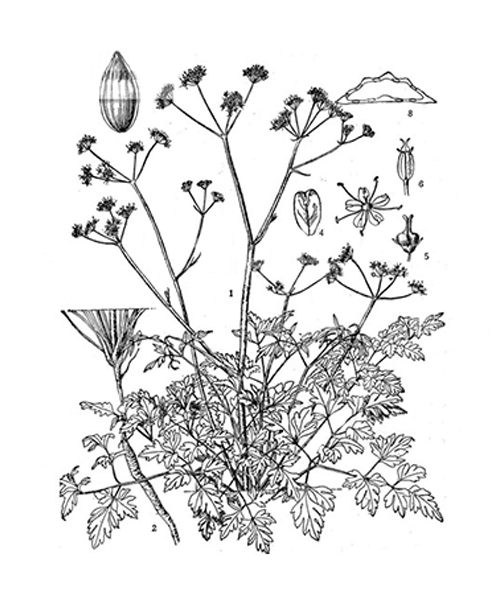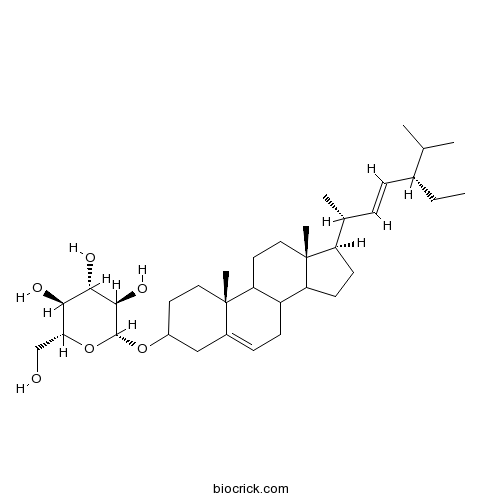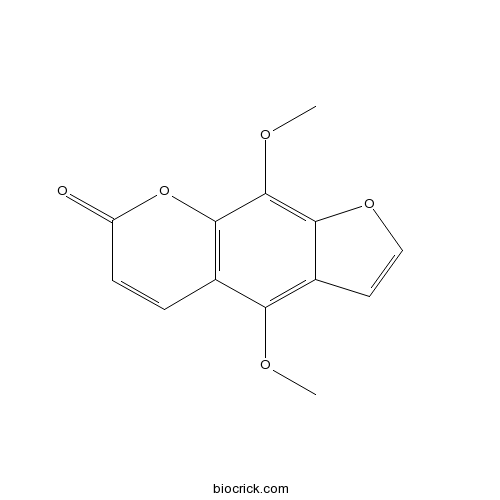Chuanminshen violaceum
Chuanminshen violaceum
1. The products in our compound library are selected from thousands of unique natural products; 2. It has the characteristics of diverse structure, diverse sources and wide coverage of activities; 3. Provide information on the activity of products from major journals, patents and research reports around the world, providing theoretical direction and research basis for further research and screening; 4. Free combination according to the type, source, target and disease of natural product; 5. The compound powder is placed in a covered tube and then discharged into a 10 x 10 cryostat; 6. Transport in ice pack or dry ice pack. Please store it at -20 °C as soon as possible after receiving the product, and use it as soon as possible after opening.

Natural products/compounds from Chuanminshen violaceum
- Cat.No. Product Name CAS Number COA
-
BCN4865
Stigmasterol glucoside19716-26-8
Instructions

-
BCN2698
Oxypeucedanin hydrate2643-85-8
Instructions

-
BCN5568
Isopimpinellin482-27-9
Instructions

[Influence of tobacco-Chuanminshen violaceum rotation on microbe community in soil].[Pubmed: 28936837]
Soil microbes are the important indicator of soil quality. For exploring Chuanminshen violaceum planting to microbial effects in tobacco soil, this paper adopted Illumina MiSeq high-throughput sequencing to research the change of bacteria and fungi at the phylum and genus in the soil. The results showed that the Ch. violaceum planting increased the biodiversity of bacteria and fungi. The influence on fungi was greater than that on bacteria. It greatly increased the sequence of fungi, it obtained 32 978 16S rDNA and 32 229 18S rDNA sequence number. There was no change of the top three phylums in bacteria, but the content changed, Proteobacteria and Acidobacteria reduced by 1.73% and 1.4% respectively, and Actinobacteria increased by 0.65%. The advantage phylum Ascomycete in tobacco reduced by 27.99% to be second advantage phylum after Ch. violaceum planting, and the second advantage phylum Basidiomycete increased by 23.69% to become the first dominant fungi. At the genus, Ch. violaceum planting changed the order of dominant genus and the abundance was also changed. Some changed largely such as uncultured Acidobacteriaceae Subgroup-1, Gemmatimonas, Subgroup-2,uncultured Nitrosomonadaceae for bacteria, norank Sordariales, norank Agaricomycetes, Phialophora for fungi. Especially the rotation increased antagonistic microbes and physiological microbes and decreased pathogenic microbes. So the Ch. violaceum planting can improve the microbe community in tobacco soil.
Antioxidant activities of the polysaccharides of Chuanminshen violaceum.[Pubmed: 27987971]
The water-soluble polysaccharides were extracted and purified from the root of Chuanminshen violaceum (CVPS). The antioxidant activities of the CVPS were evaluated both with in vitro and in vivo experiments. The results of the in vitro antioxidant assay suggested that the CVPS scavenged DPPH, hydroxyl, and superoxide anion radicals. The oral administration of three different doses of CVPS administered over a period of 6 weeks to D-galactose induced aging mice models, enhanced the activities of T-SOD, Mn-SOD, Cu, Zn-SOD, and CAT, and markedly decreased the content of MDA. Therefore, significant up-regulation of mRNA expression levels of Cu, Zn-SOD, Mn-SOD, CAT, glutathione peroxidase 1 (GPx), thioredoxin 1 (Trx1), and thioredoxin 2 (Trx1) occurred. Finally, the results demonstrated that the CVPS are a novel potential resource for natural antioxidants and anti-aging drugs.
Effect of extraction methods on the properties and antioxidant activities of Chuanminshen violaceum polysaccharides.[Pubmed: 27581557]
None
Selenylation modification can enhance immune-enhancing activity of Chuanminshen violaceum polysaccharide.[Pubmed: 27561500]
Chuanminshen violaceum polysaccharides (CVPS) were extracted, purified and selenizingly modified. The modification has been achieved by using the HNO3- Na2SeO3 method, and selenizing Chuanminshen violaceum polysaccharides (sCVPS) were evaluated for their physicochemical properties and their potential as adjuvant to modulate cellular and humoral immune responses to hepatitis B subunit vaccine in a mouse model. Our results demonstrated that sCVPS significantly promoted splenocytes proliferation and the production of IL-4 and IFN-γ in vitro. In vivo experiments showed that sCVPS significantly increased the rHBsAg-specific IgG level, IgG subclass (IgG1, IgG2a, and IgG2b) antibody titers, T cells proliferation, levels of IL-4, IL-2, and IFN-γ in CD4 (+)T cells and the level of IFN-γ in CD8(+)T cells. Furthermore, sCVPS increased the activity of natural killer cells and cytotoxic T lymphocytes, thus increasing both cellular and humoral immune responses in vivo. The present data suggest that selenylation of CVPS can significantly improve their immune-enhancing activity both in vitro and in vivo, thus representing a powerful adjuvant for vaccine design.
Extraction, characterization and antioxidant activities of polysaccharides of Chuanminshen violaceum.[Pubmed: 26806648]
A single factor experiment and Box-Behnken design were applied to optimize the microwave-assisted extraction (MAE) of Chuanminshen violaceum polysaccharides (CVPs). The CVPs yield was 34.59 ± 0.51%, which was in accordance with the predicted value of 35.54%, under the following optimum conditions: microwave power of 466 W, extraction temperature of 64.5 °C, extraction time of 15 min, and water-raw material ratio of 40 mL/g. Two CVPs fractions (CVPs-I and CVPs-II) were obtained via stepwise ethanol precipitation. CVPs-II was further purified using DEAE cellulose-52 chromatography to obtain the major fraction of CVPs-IIa. Fourier transform infrared spectroscopy (FTIR) and GC-MS analysis revealed that crude CVPs, CVPs-I, and CVPs-II were neutral polysaccharides and were mainly composed of glucose and galactose. The molecular weights of CVPs-I and CVPs-IIa were 233.69 and 11.02 kDa, respectively. Furthermore, all samples exhibited certain antioxidant activity or reducing power to scavenge the DPPH and ABTS radicals, among which CVPs-II was the strongest. In conclusion, MAE is an efficient method for extracting CVPs of C. violaceum, and this plant root has the potential to be explored as a source of natural antioxidants.
Authentication of commercial processed Glehniae Radix (Beishashen) by DNA barcodes.[Pubmed: 26628908]
The radix of Glehnia littoralis Fr. Schmidt ex Miq. (Beishashen), is often misidentified and adultered in Chinese medicine. Its seven common adulterants include Chuanminshen violaceum Sheh et Shan (Chuanmingshen), Changium smyrnioides Wolff (Mingdangshen), Sphallerocarpus gracilis (Bess.) K.-Pol. (Miguoqin), Adenophora polyantha Nakai (Shishashen), Silene tatarinowii Regel (Shishengyingzicao), Adenophora tetraphylla (Thunb.) Fisch (Lunyeshashen) and Adenophora stricta Miq. (Shashen). This study aims to evaluate the feasibility of the second internal transcribed spacer (ITS2) DNA barcoding to discriminate between Glehniae Radix and its common adulterants.
Chuanminshen violaceum polysaccharides improve the immune responses of foot-and-mouth disease vaccine in mice.[Pubmed: 25934108]
Water-soluble polysaccharides from Chuanminshen violaceum (CVPS) were evaluated for their physicochemical properties, monosaccharide composition, and adjuvant potential to specific cellular and humoral immune responses in a mouse model of foot-and-mouth disease virus (FMDV) vaccination. The average molecular weight (Mw) of the CVPS was 968.31 kDa. The monosaccharide components of the CVPS was rhamnose, arabinose, fucose, mannose, glucose, and galactose with a relative mass of 6.29%, 21.87%, 16.59%, 12.54%, 13.07%, and 28.05%, respectively. Administering CVPS as an adjuvant significantly enhanced the phagocytic capacity of peritoneal macrophages, splenocyte proliferation, and the activity of NK cells and CTL as well as increased FMDV-specific IgG and IgG subclass antibody titers. Moreover, CVPS increased the expression of IL-2, IFN-γ, and IL-4 in CD4(+) T cells and IFN-γ expression in CD8(+) T cells. Additionally, CVPS enhanced CD40(+), CD80(+), and CD86(+) expression on DCs. Moreover, CVPS upregulated MHC-I/II, TLR-2/4 mRNA levels. In contrast, CVPS downregulated TGF-β mRNA expression and the frequency of CD4(+)CD25(+)Foxp3(+) Treg cells. Taken together, these results indicate that administering CVPS as an adjuvant enhances both cellular and humoral immune responses via the TLR-2 and TLR-4 signalling pathways, thereby promoting DC maturation and suppressing TGF-β expression and Treg frequency.
Antiviral activity of sulfated Chuanminshen violaceum polysaccharide against duck enteritis virus in vitro.[Pubmed: 23523763]
Duck enteritis virus (DEV) of the family Herpesviridae is one of the main diseases in waterfowl. Despite the wide use of vaccines to control the disease, infection with the virus cannot be completely prevented. Therefore, antiviral agents against DEV should be developed. This study presents a novel sulfated polysaccharide from Chuanminshen violaceum (sCVPS), which exhibits significant antiviral activity against DEV with 50% inhibitory concentrations (IC₅₀) ranging from 77.12 μg/mL to 104.81 μg/mL. sCVPS is more effective than heparan sulfate (HS, as a positive control) with IC₅₀=132.61 μg/mL. sCVPS and HS inhibit viral activity by preventing virus adsorption with IC₅₀ values ranging from 82.83 μg/mL to 109.28 μg/mL for sCVPS and 150.22 μg/mL for HS. Direct immunofluorescence assay and transmission electron microscopy demonstrated that the mechanism of action was the interference with virus adsorption. The amount of inhibited virus during adsorption was quantified using fluorescent quantitative polymerase chain reaction, which revealed that both sCVPS and HS can significantly reduce all viruses attached to cells. sCVPS also prevented the cell-to-cell spread of DEV. These results indicated that sCVPSs perform more effectively than does HS as antiviral agents against DEV and can be further examined for potential effects as an alternative control measure for DEV infection.


